[/caption]
Employees at the Kennedy Space Center got together today to “build” their own space shuttle, to honor the shuttle program’s 30-year history. See a time-lapse video of how they did it, below:
Via the @NASAKennedy Twitter feed
[/caption]
Employees at the Kennedy Space Center got together today to “build” their own space shuttle, to honor the shuttle program’s 30-year history. See a time-lapse video of how they did it, below:
Via the @NASAKennedy Twitter feed
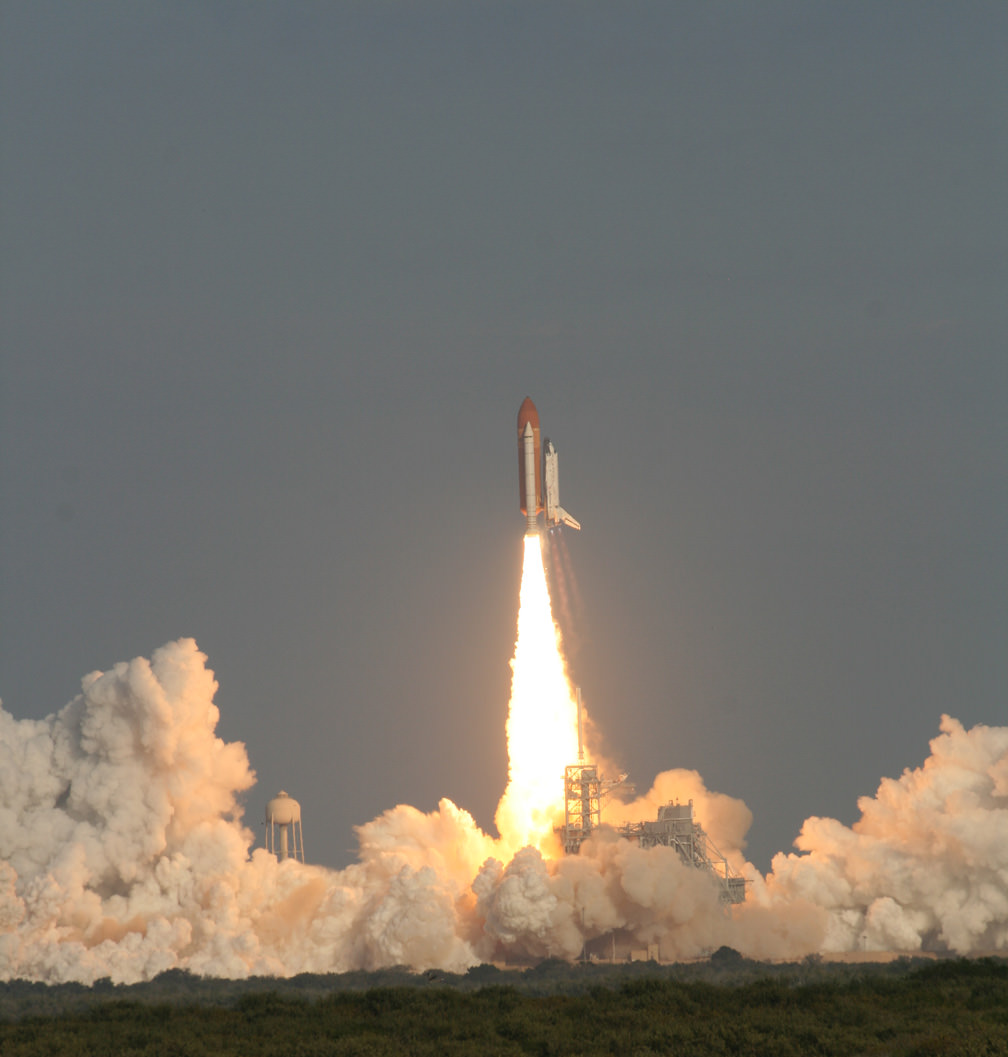
Watch the HD version. More photos below
Imagine ….. “You Are There ! ”
… in the middle of the whooping, cheering crowd at the Kennedy Space Center (KSC) for the historic final launch of Space Shuttle Discovery on the STS-133 mission to the International Space Station.
That’s the feeling you’ll get from this exquisite and exciting piece from amateur videographer Anton Janssen from the Netherlands. Anton has captured the sights and sounds of excitement of the giant crowd in the thick of the action in this amazingly sharp video of Discovery’s last blast to space.
Anton’s vantage point from the NASA Causeway enabled him to film the liftoff with a birds eye view of the entire orbiter to the base of the launch pad – not blocked by the launch gantry at all. And to top that off, the video shows panoramic reaction shots of the large and exuberant crowd. What’s more is you can hear the cheering multitudes at multiple milestones as Discovery ascends with a deafening roar and spewing intense scorching flames out her rear like a gigantic blowtorch burning an indelible hole in the sky.
I happened to meet Anton at Port Canaveral a few days after the launch as Discovery’s powerful Solid Rocket Boosters (SRB’s) were being towed along the canal following their retrieval from the Atlantic Ocean.
[/caption]
Anton told me he bought the camera new and especially for the STS-133 launch after he purchased one of the very hard to get VIP Tickets from the KSC Visitor Complex. He arrived at the viewing site several hours early, along with tens of thousands of other onlookers along the Florida Space Coast beaches and roadways.
“The NASA Causeway was a great viewing site because you could see the shuttle right from the start,” Anton explained.
Check out this amazing close up video view of the final moments of Discovery’s final landing and the finale of her space career as record by Matt Travis, of Spacearium, taken at the Shuttle Landing Facility where I was also stationed.
This timelapse of Discovery’s launch was shot from the Kennedy Space Center Causeway Viewing Site, by David Gonzales of Project Soar. (See our previous article about them.) Here, approximately 12 minutes is condensed into 27 seconds, so about 27 times as fast. Replayed at 15 fps. See the launch and smokey plume change over time as it is tugged on by wind.
Only 1 or 2 flight remain for the Space Shuttle Program until they are forcibly retired for lack of money.
Next up is the launch of Endeavour on April 19 at dusk. Should make for some extremely cool videos and snapshots! Get your gear ready!
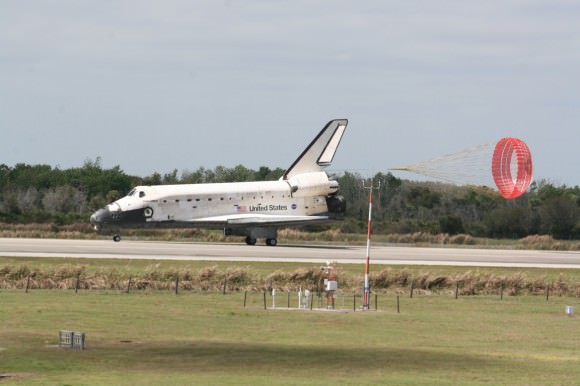
[/caption]
A worker at the space shuttle launch pad at Kennedy Space Center, pad 39A, fell to his death early Monday morning, according to reports. An employee of United Launch Alliance fell from the launch pad tower near space shuttle Endeavour. NASA released the following statement:
“At about 7:40 a.m. EDT this morning, a United Space Alliance worker fell at NASA Kennedy Space Center’s Launch Pad 39A. NASA emergency medical personnel responded, but they were unable to revive the man. Because of medical privacy, currently we’re not able to release any additional details about this fatality. Family members are being notified. All work at Launch Pad 39A has been suspended for the rest of the day, and counseling and other employee assistance are being provided to workers. Right now our focus is on our workers and for the family of the USA employee. The incident is under investigation.”
Our condolences to the man’s family and his United Launch Alliance co-workers.
UPDATE:
USA has now released the name of the person involved in the accident at the launch pad as engineer James D. Vanover.
“Our heartfelt sympathy goes out to the family of Mr. Vanover,” United Space Alliance Chief Executive Officer Virginia Barnes said in a statement. “Our focus right now is on providing support for the family, and for his coworkers. We are also providing our full support to investigating officials in order to determine the cause of the incident as quickly as possible. Until that investigation is complete, it would be inappropriate to provide further comment on the details.”
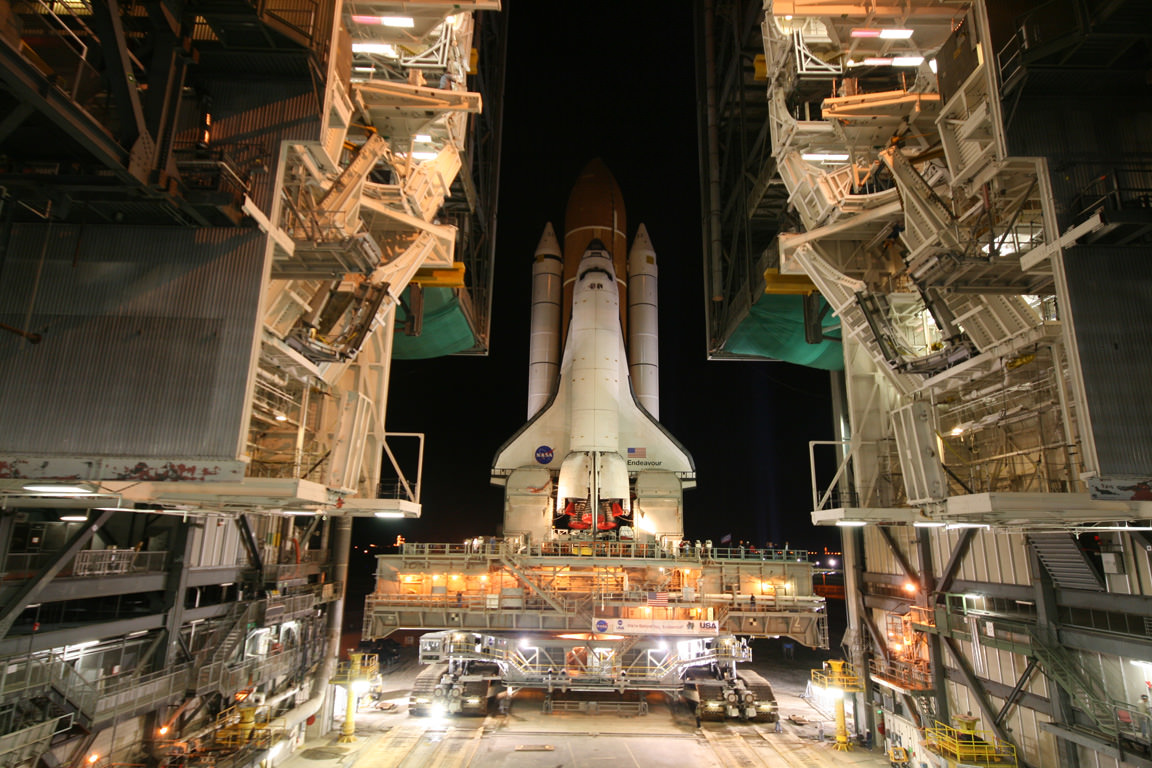
[/caption]
CAPE CANAVERAL – The youngest orbiter in NASA’s shuttle fleet headed to Launch Complex 39A at Kennedy Space Center in Florida for the last time on Friday, Mar. 10. The shuttle started its slow trek out to the launch pad around 8 p.m. EST. Endeavour is being prepared for the STS-134 mission which is scheduled to launch on Apr. 19 at 7:48 p.m. EST.
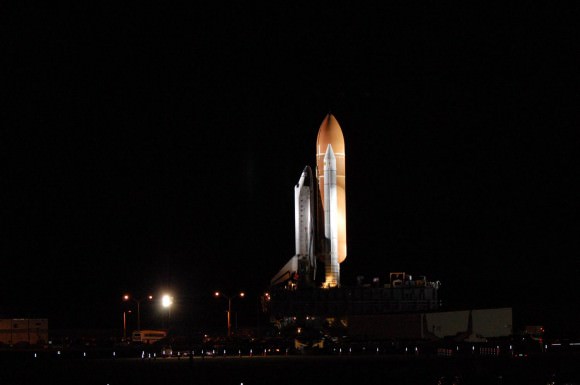
Endeavour was wheeled out of NASA’s massive Vehicle Assembly Building (VAB) on top of the crawler-transporter. This huge, tracked vehicle moves at a blistering pace of about a mile an hour. Therefore it took Endeavour several hours to reach LC39A. What is known as “Rollout” had been slated to occur the day prior, but a front of nasty weather blew in and shuttle managers decided to push the trip back a day.
The STS-134 will be Endeavour’s 25th and final mission. It is a resupply flight to the International Space Station. Its payload consists of the Alpha Magnetic Spectrometer -02 (AMS-02) as well as the Express Logistics Carrier-3.
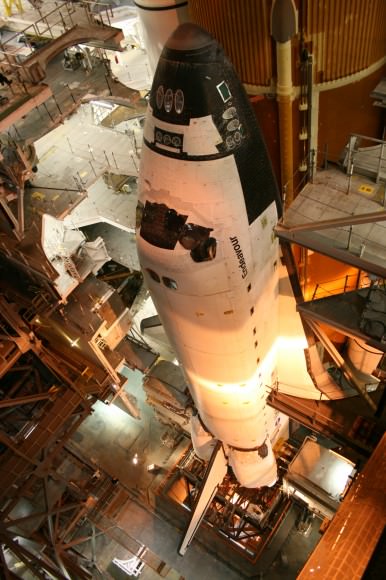
“As exciting as it will be to fly this mission, what’s even more exciting is the science that this flight will bring to the International Space Station,” said STS-134 Pilot Greg Johnson. “I have no doubt that the AMS-02 will teach us new things about how the universe works and it may even show us new particles that we didn’t even know existed.”
Commander Mark Kelly will lead the crew of six, Johnson is the pilot and the Mission Specialists will be Mike Fincke, Andrew J. Feustel, Greg Chamitoff and European astronaut Roberto Vittori.
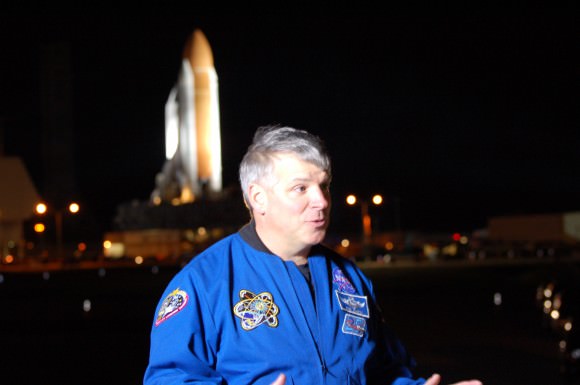
For a while it was uncertain whether-or-not Mark Kelly, the mission’s commander would be on this historic flight. His wife, Congresswoman Gabrielle Giffords, was severely injured when she was shot in the head by alleged gunman Jared Lee Loughner. NASA named Rick Sturckow as the mission’s backup commander. However, Kelly announced later that he would remain the mission’s commander and resumed training with his crewmates. By all accounts, it was Giffords that encouraged him to continue and it appears that she will back at Kennedy Space Center when the mission launches.
“While all of us that have worked on Endeavour are a little sad that this is her final mission, we remained focused on conducting her last flight as safely as possible,” said Endeavour’s Flow Director, Dana Hutcherson.

Endeavour was constructed after the loss of Challenger in 1986. The orbiter first flew in 1992. After the STS-134 mission concludes there will only be one flight remaining in the shuttle program, STS-135, currently slated for a June 28 launch. It has been hinted that Endeavour might end up staying at Kennedy Space Center – at the Kennedy Space Center Visitor Complex. However, an official announcement has yet to be made.
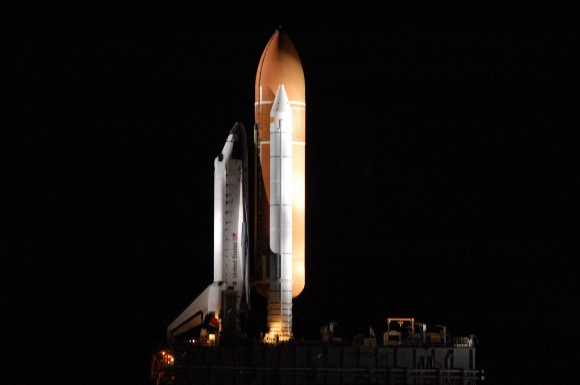
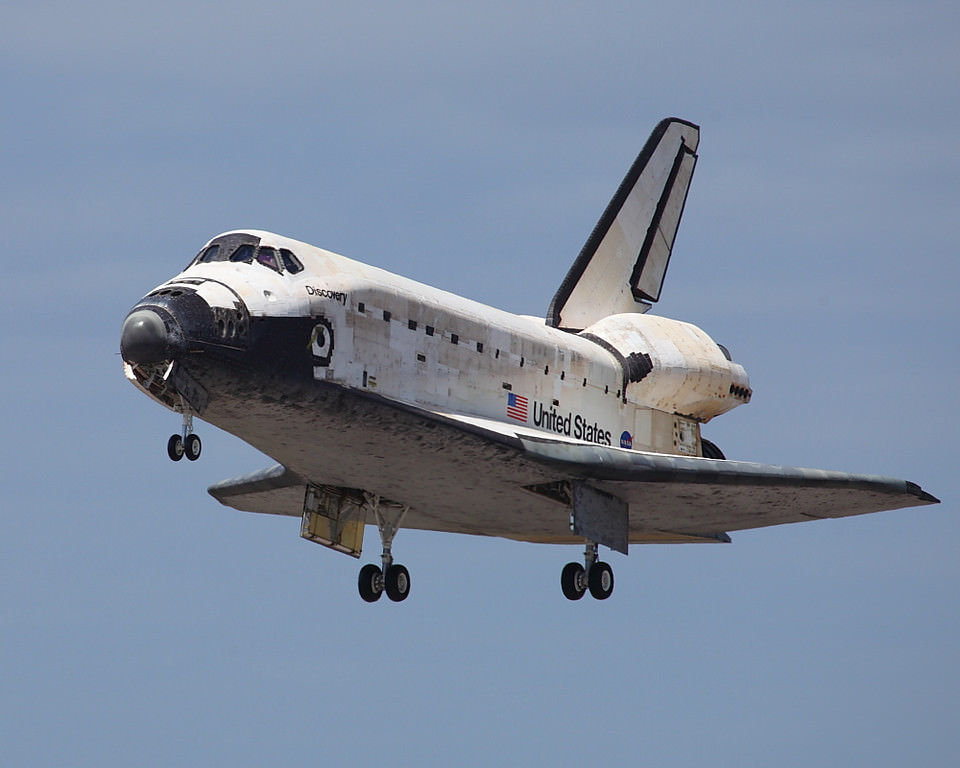
[/caption]
CAPE CANAVERAL – After logging over a year’s worth of flight time in space, the space shuttle Discovery wrapped up a historic career by safely touching down at NASA’s Kennedy Space Center (KSC) in Florida at 11:57 a.m. EDT. The shuttle landed at KSC’s Shuttle Landing Facility on runway 15.
Discovery’s final mission was a resupply flight to the International Space Station (ISS). The shuttle delivered the Leonardo Permanent Multipurpose Module (PMM) to the orbiting outpost. Among other things, the PMM carried the first humanoid robot in space – Robonaut-2 (R2) inside. R2 is also the first robot that the U.S. has flown to the ISS.
The crew that flew Discovery on her final mission consisted of Commander Steve Lindsey, Pilot, Eric Boe and Mission Specialists; Alvin Drew, Nicole Stott, Michael Barratt and Stephen Bowen. Bowen actually was not slated to fly this mission; he was a last-minute replacement for Tim Kopra who broke his hip in a bicycle accident in January.
The lead-up to Discovery’s final mission was one filled with technical hurdles that NASA’s engineers had to overcome before the shuttle thundered one last time to orbit. On the Nov. 5 launch attempt a leak at the Ground Umbilical Carrier Plate (GUCP) caused a scrub. Upon inspection technicians found a section of popped-up foam on the shuttle’s external tank – this led them to discovering numerous, small cracks in the aluminum body of the external tank itself.
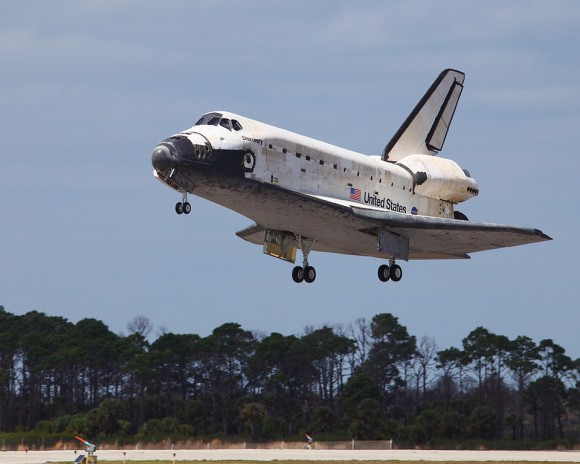
When Discovery was set to launch on Feb.24, a range issue crept up at the last minute almost scrubbing the launch. It was cleared with only seconds to spare.
Discovery’s service record is a distinguished one. Whenever NASA had a critical mission to fly – Discovery got the nod. The orbiter carried Sen. Jake Garn as well as former Mercury astronaut and Senator John Glenn to orbit. It delivered the Hubble Space Telescope to space. And it returned the U.S. space program to orbit, twice, after the Challenger and Columbia accidents.
“If you think of a vehicle that’s 27 years old, you never see a vehicle that age that never comes back with no flaws, however Discovery did just that, she functioned flawlessly,” said Commander Steve Lindsey upon landing. “This is a tribute to the Kennedy Space Center team.”
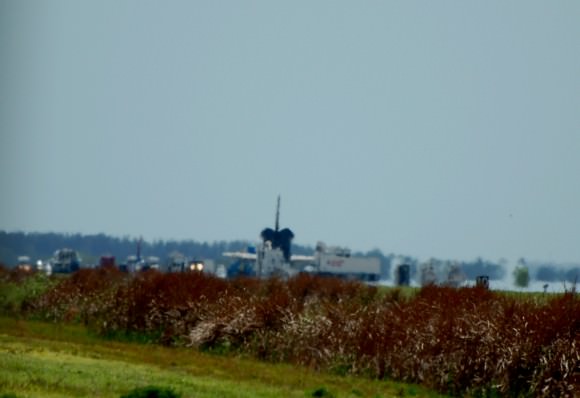
The next phase of Discovery’s career is retirement; she will now head to the Smithsonian Institute’s Steven F. Udvar Hazy Center in Washington D.C. where she will be put on display. Discovery will take the place where Discovery currently resides.
“Discovery is an amazing spacecraft and she has served her country well,” said NASA Administrator Charles Bolden. “The success of this mission and those that came before it is a testament to the diligence and determination of everyone who has worked on Discovery and the Space Shuttle Program, over these many years. As we celebrate the many accomplishments of this magnificent ship, we look forward to an exciting new era of human spaceflight that lies ahead.”
There are only two missions left in the shuttle program, STS-134 onboard Endeavour which is slated to fly on Apr. 19 and STS-135 which will be flown by Atlantis on June 28.
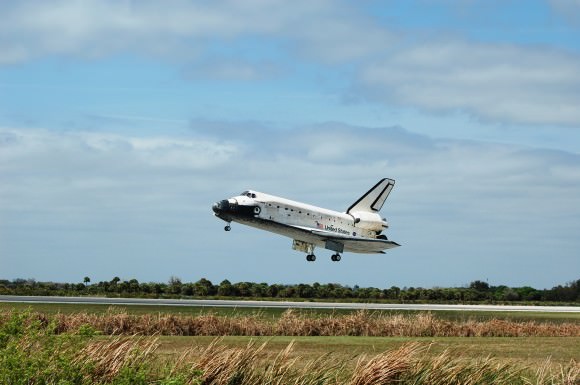
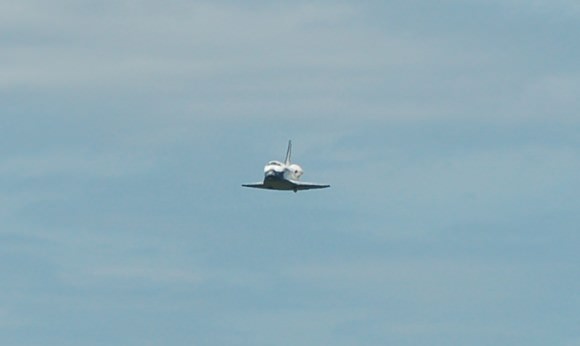
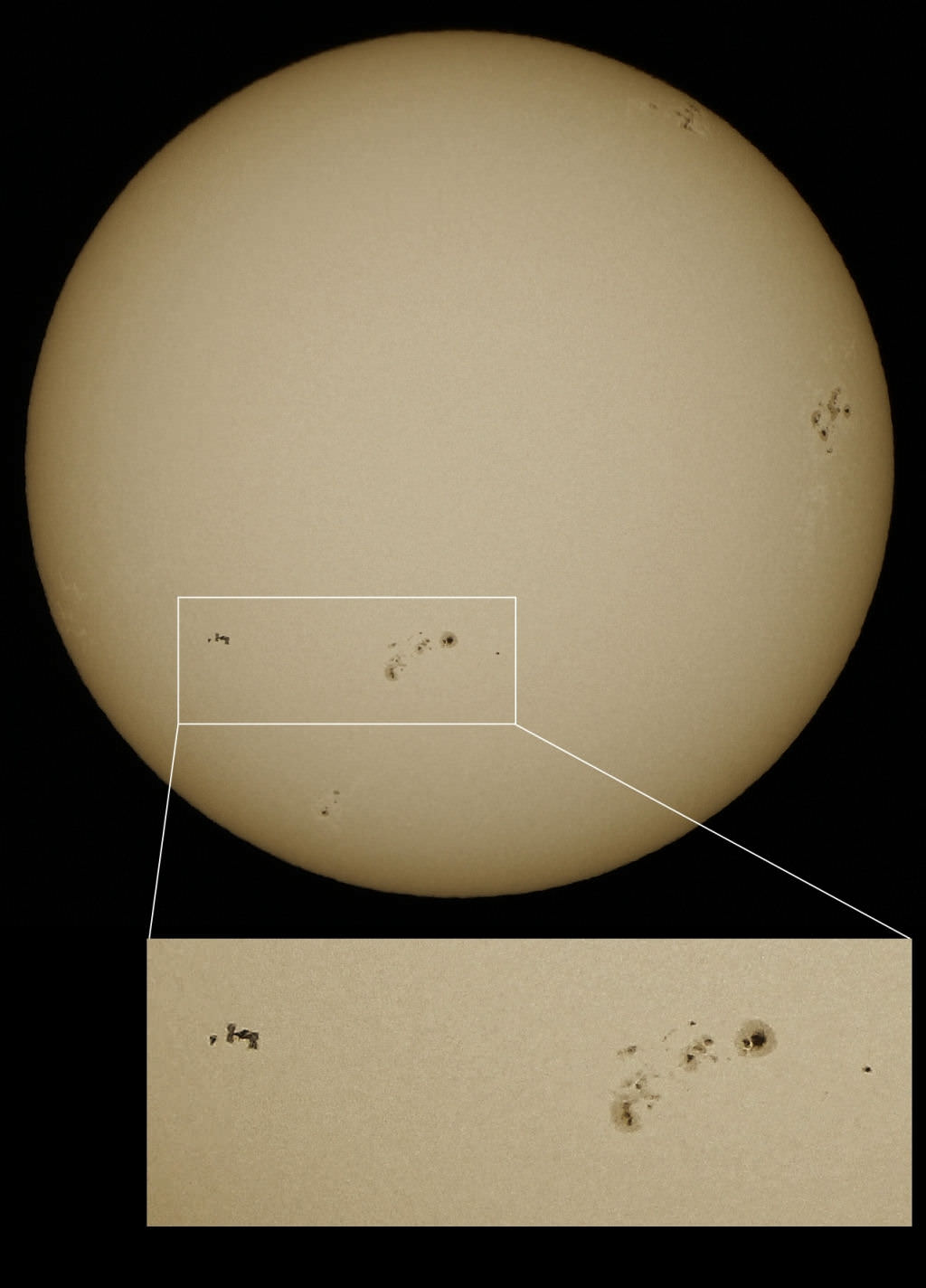
[/caption]
Amateur astronomer Catalin Fus from Poland has captured one of the most amazing images I’ve ever seen – and his timing was impeccable. On March 7th at 13:05:49 UTC, just after space shuttle Discovery had undocked from the International Space Station, the two ships flew in formation directly in front of the Sun, as seen from Fus’ location just outside of Krakow. With his solar-filtered telescope focused on active sunspot region 1166, he found there were a couple extra spots in his image – Discovery and the ISS. Given that this was Discovery’s final mission in space and final visit to the ISS, this image has historical significance, as well as just being absolutely fantastic. Keep in mind that transits like this last just over a half a second.
He used the following equipment:
Telescope : 102mm f6.3 GPU oilspaced apochromat
self-made Herschel Prism + Meade TeleXtender 2x 1.25”
Mount: Losmandy G11
Camera: Canon EOS 550D
1frame @ ISO 100, 1/1000s
With just a touch of post processing done in PixInsight and PS CS5
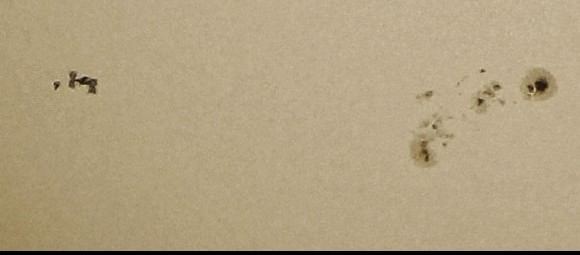
You can see more Fus’ handiwork at his website, www.catalinfus.ro. Our thanks to Catalin for allowing Universe Today to post his incredible image.
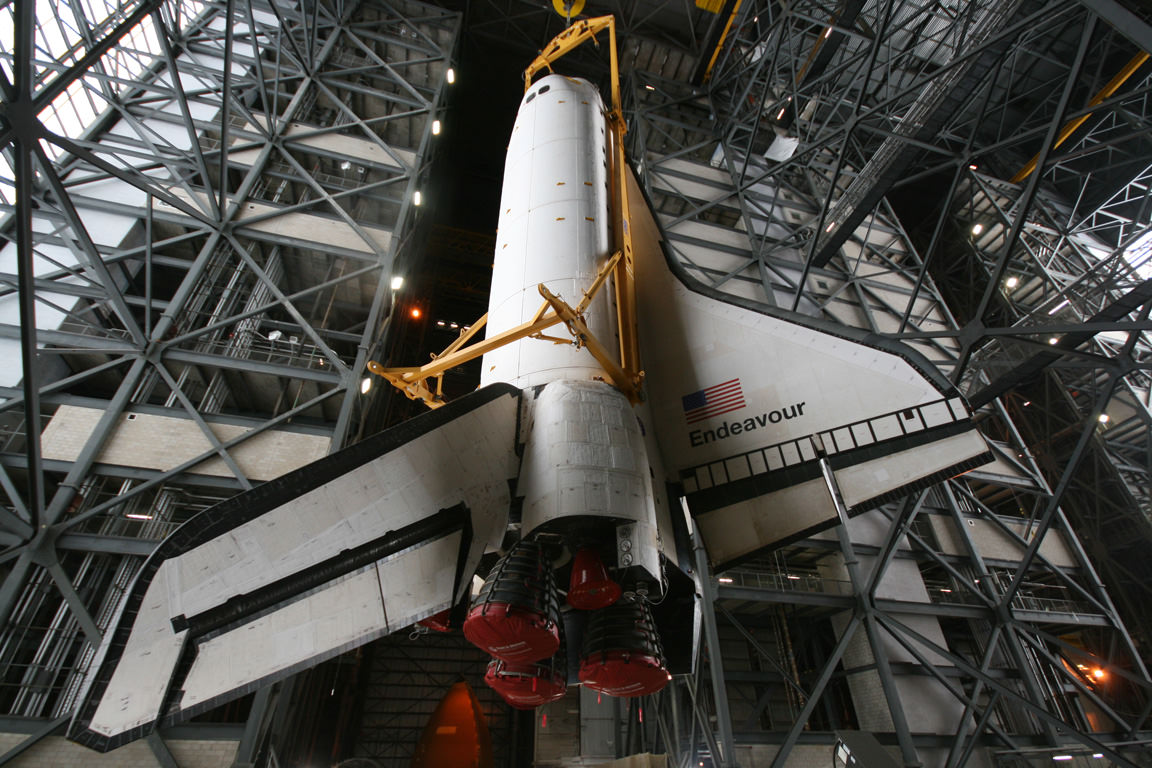
[/caption]
For the final flight of Space Shuttle Endeavour, I was privileged to be one of the lucky few to be an eyewitness to how the orbiter was hoisted and attached for the last time to the External fuel tank and twin solid rocket boosters that will power her last ascent to space on the STS-134 mission . Thereafter she will be retired from active duty service.
“Lift and Mate” is the formal name for the nearly day and a half long intricate process to join Endeavour to the fuel tank and rocket boosters and took place after the orbiter was hauled inside the 52 story Vehicle Assembly Building atop a 76 wheeled transporter on Feb. 28.
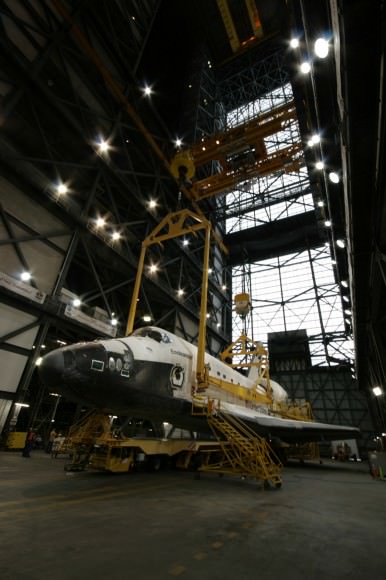
Lift and Mate is a jaw dropping and unforgettable experience because you see the orbiter suspended in mid air as though it was flying in space. While hanging in the air by thin cables, the 100 ton orbiter is reminiscent to me of what astronauts on the International Space Station surely see as the shuttle approaches for docking.
Following the shuttles rollover to the VAB on top on the transporter, technicians initially attached a large yellow, metal sling to Endeavour in the center area of the VAB – known as the transfer aisle.
Endeavour was then slowly and methodically hoisted on pulleys and chains into the vertical position. The tail came to rest just a few meters from the hard and unforgiving concrete floor. The orbiter was then lifted up to the VAB ceiling and carefully moved over walkways into High Bay 3. Media including myself watched this entire process in total awe from several different levels inside the VAB as Endeavour was lifted past us from just a few meters away.
The final step was to lower Endeavour into position for mating to the fuel tank and solid rocket boosters already awaiting her arrival.
Its hard to believe I was really an eyewitness to this majestic event and also sadly realize it will never happen again.
“The orbiter has a lot of life left in her,” said a top shuttle manager to me. “The shuttle could fly many more missions.”
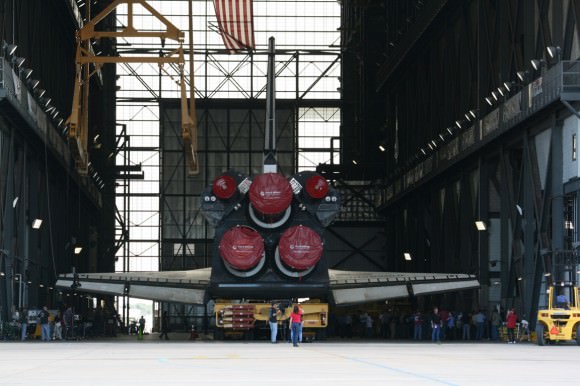
NASA will rollout Endeavour to Launch Pad 39 A on March 9 following the landing of Space Shuttle Discovery.
The STS-134 mission will be the 25th and final flight for shuttle Endeavour. Launch is set for April 19. Endeavour will haul the $2 Billion Alpha Magnetic Spectrometer (AMS) to orbit and attach it to the ISS. AMS will search for dark matter and seek to determine the origin of the universe.
Check out the majestic views of “Lift and Mate” for Space Shuttle Endeavour in my photo album herein
Final “Lift and Mate” of Space Shuttle Endeavour. Photos by Ken Kremer
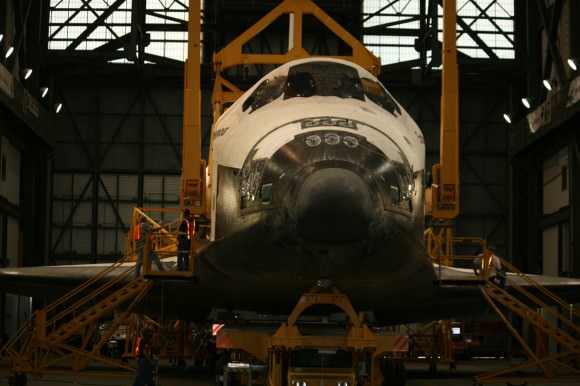
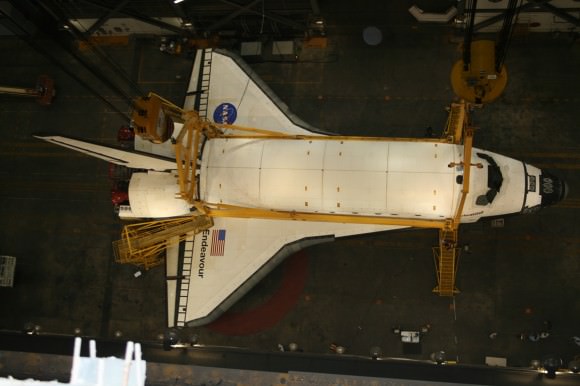
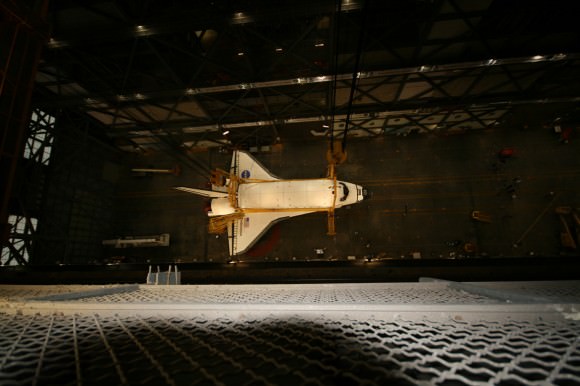
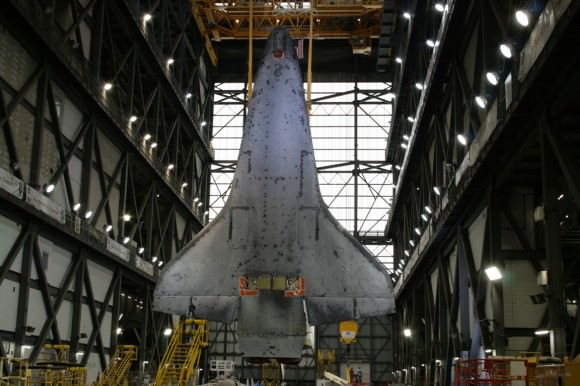
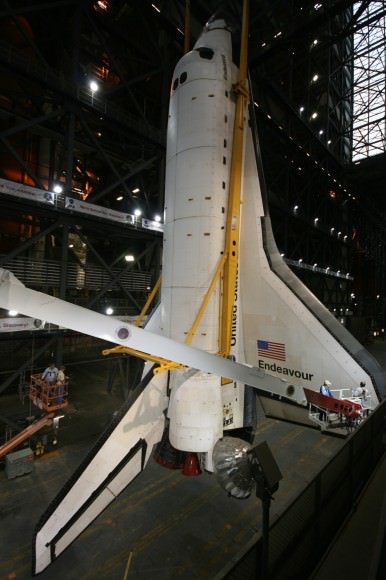
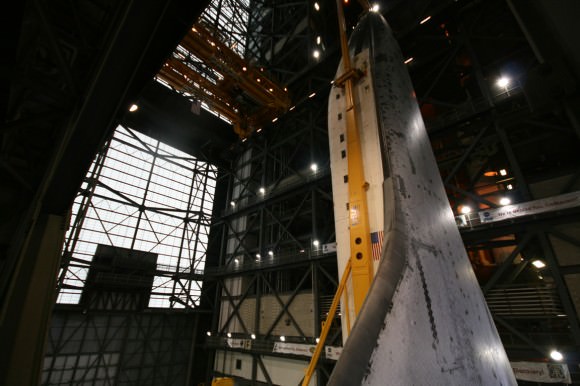
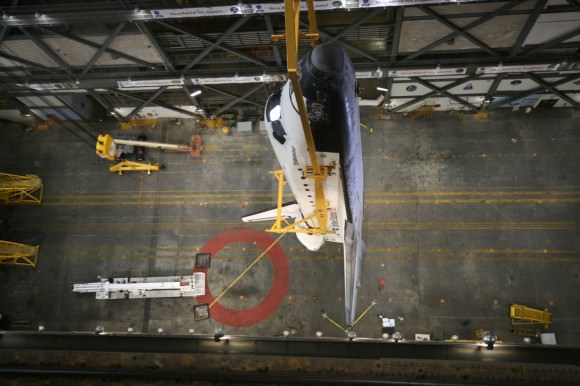
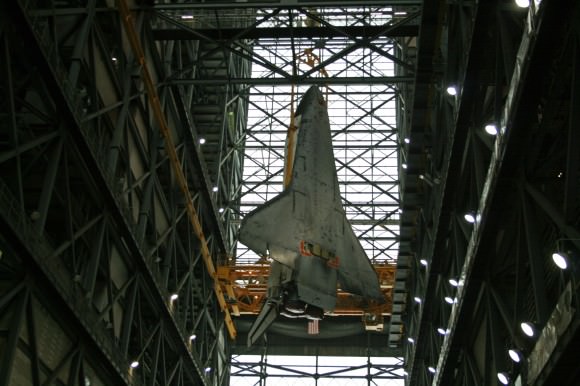
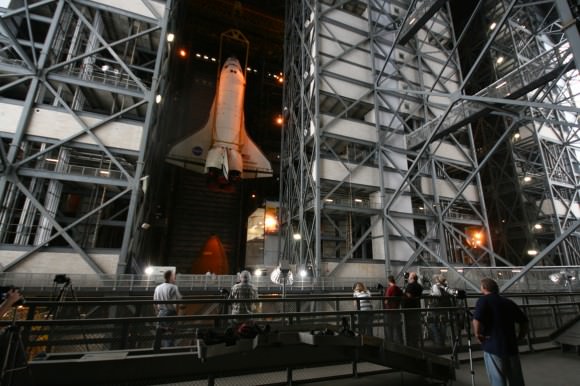
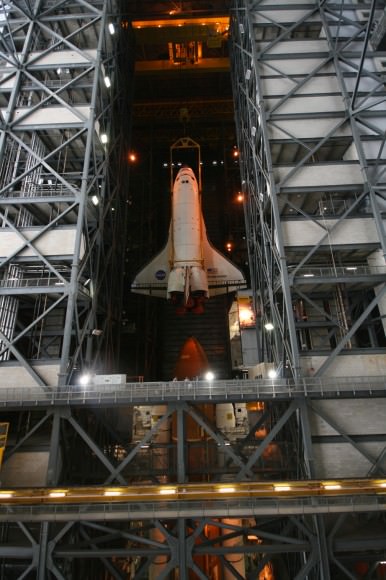
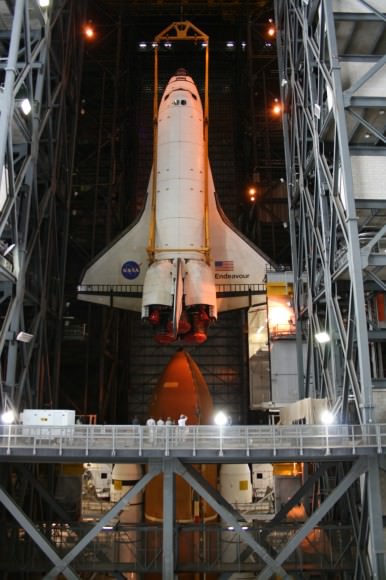
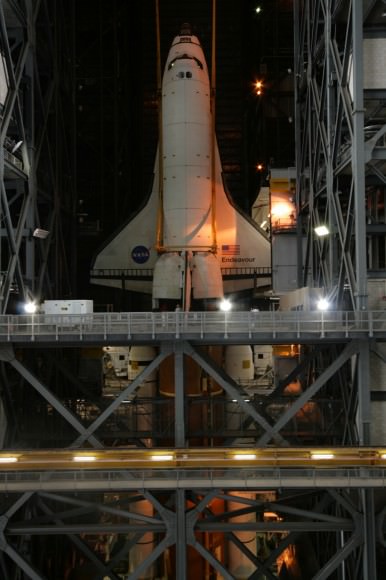
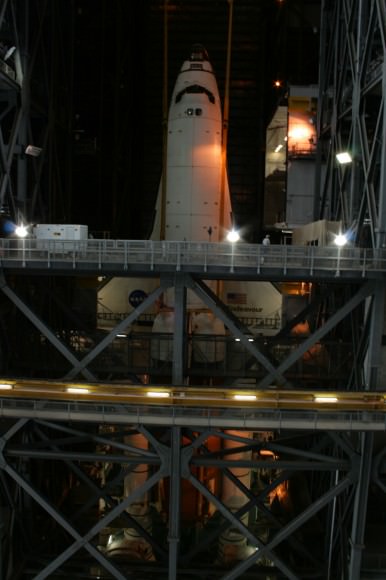
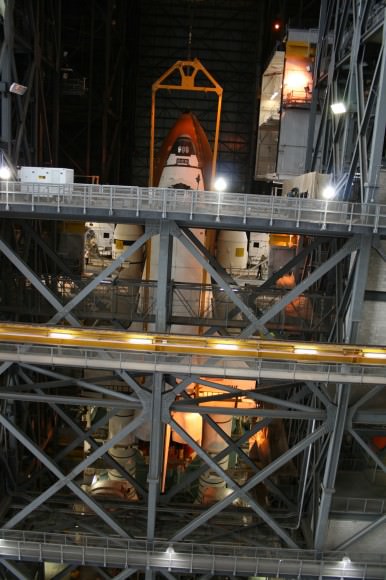
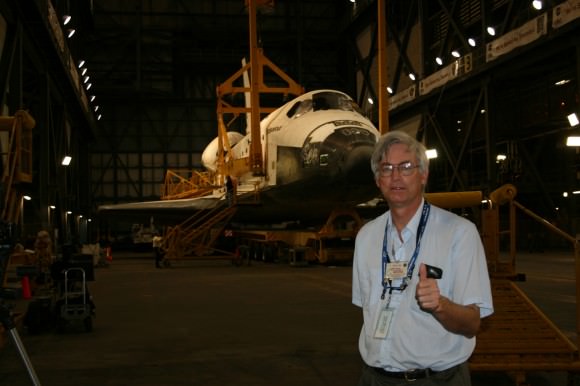
The STS-133 crew sent down a video from orbit today where they each paid tribute to the legacy of space shuttle Discovery. My favorite line was from Nicole Stott: “I’m looking forward to bringing her home to the people who care for her the most, to the time when we are on the runway and can look back and still see her standing on her own gear, with her own proud wings holding her up before she goes back to that hanger for the last time.”
[/caption]
As space shuttle Discovery prepares to return home from its final mission to space, let’s take a look back at the STS-133 mission, an historic “last” for the program’s most-traveled shuttle. “I think the legacy that this shuttle has made for herself is just nothing short than cause for celebration,” said mission specialist Michael Barratt during press conference from orbit on March 8.
“It’s going to be sad when it’s over, when we land tomorrow or the next day,” said STS-133 commander Steve Lindsey. “The hardest part of this for me is giving up the capability. It can do everything except leave low-Earth orbit…There is not a single thing wrong with her. Every single system and every piece of every system is working just like it’s brand new.”


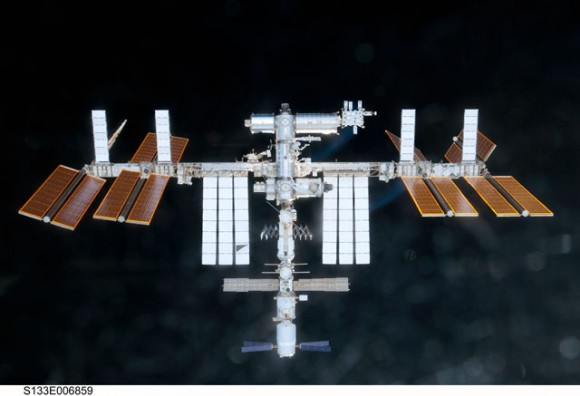
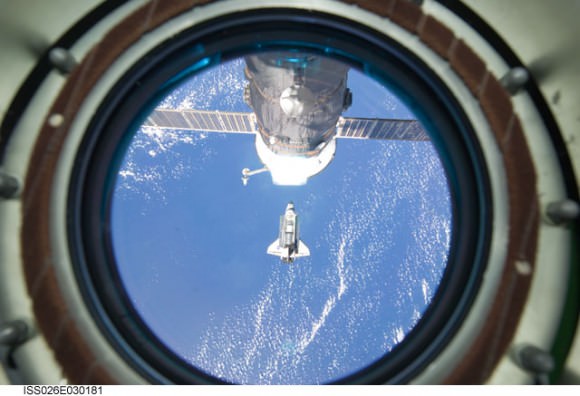
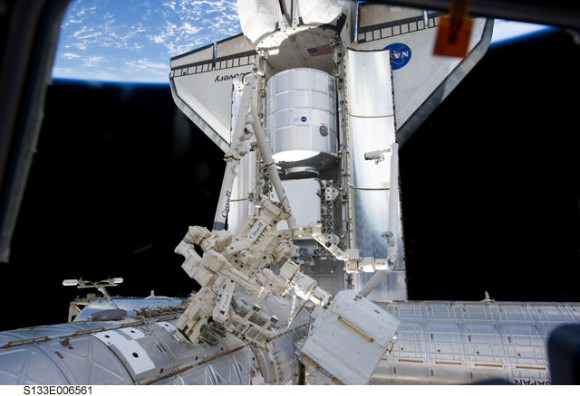
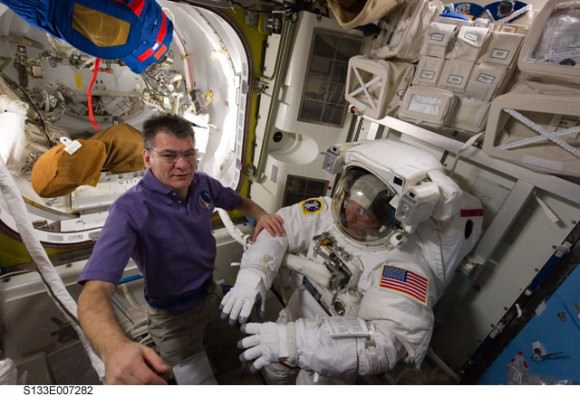
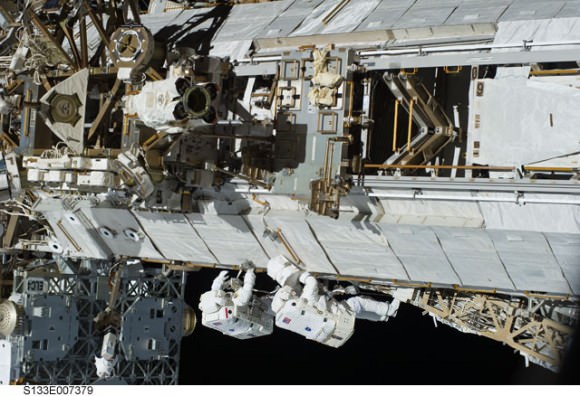
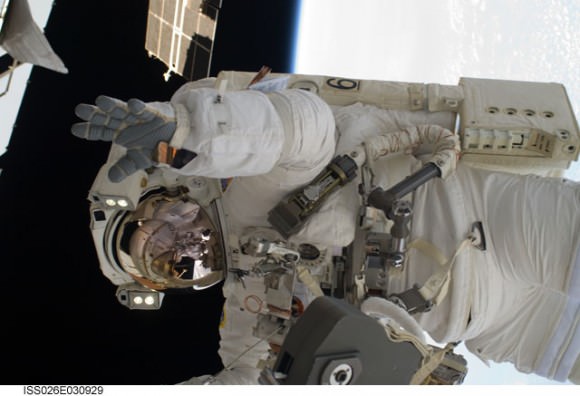
The first spacewalk of the mission lasted six-hours and 34-minutes. Alvin Drew and Steve Bowen installed a power extension cable, move a failed ammonia pump module to the External Stowage Platform 2 on the Quest Airlock for return to Earth at a later date, installed a camera wedge on the right hand truss segment, installed extensions to the mobile transporter rail and exposed the Japanese “Message in a Bottle” experiment to space.
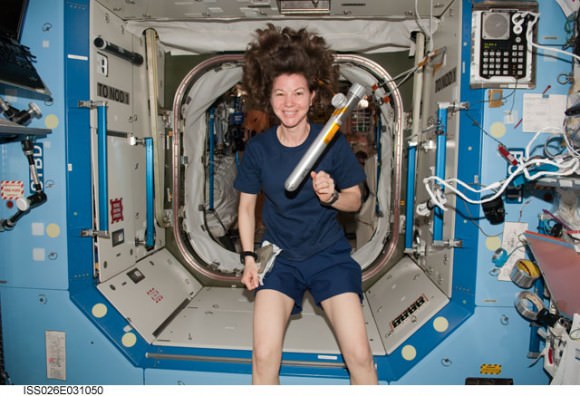
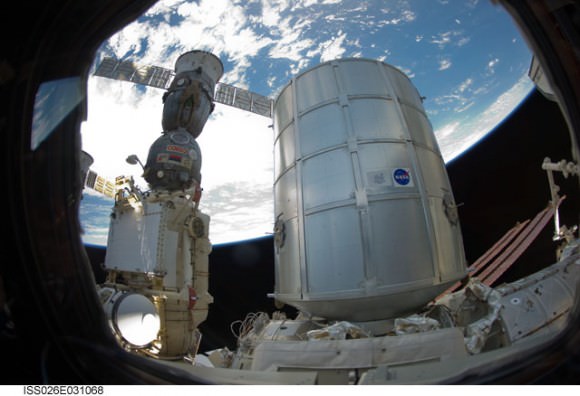
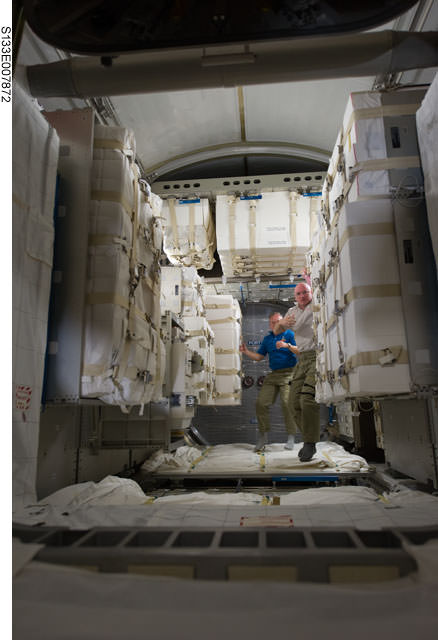
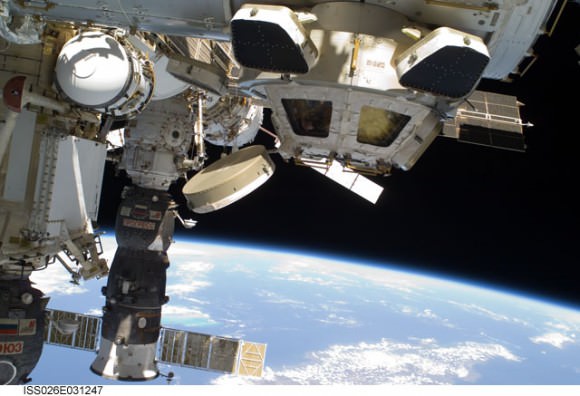
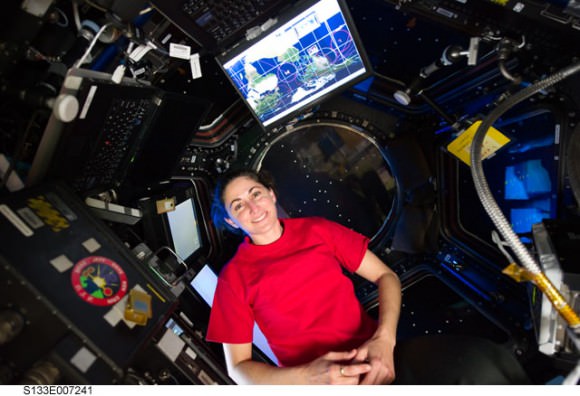
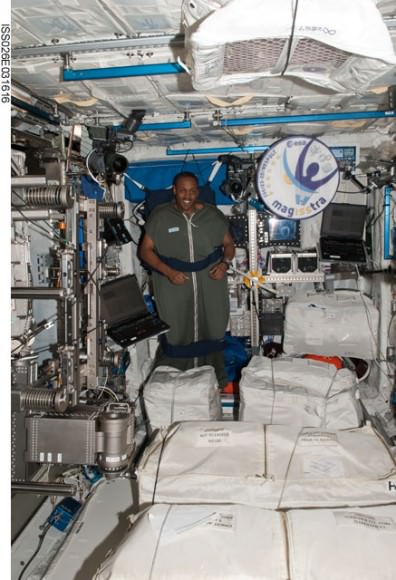
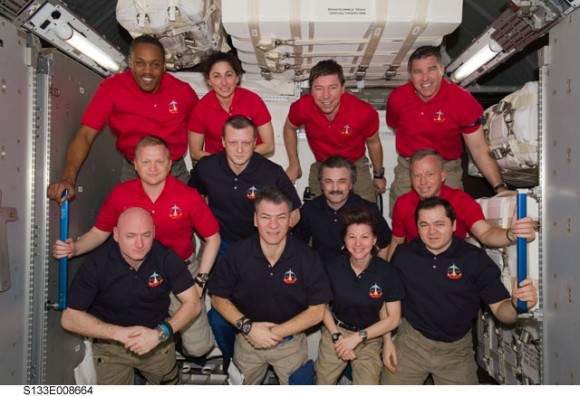
Joint crew photo inside the newest module, the PMM — which is basically a big storage closet for the ISS. The STS-133 crew members, all attired in red shirts(from left)are NASA astronauts Alvin Drew, Eric Boe (below), Nicole Stott, Michael Barratt, Steve Bowen and Steve Lindsey (below). The dark blue-attired Expedition 26 crew members, from bottom left, are NASA astronaut Scott Kelly, European Space Agency astronaut Paolo Nespoli, NASA astronaut Cady Coleman along with Russian cosmonaut Oleg Skripochka. In the center of the photo are Dmitry Kondratyev and Alexander Y. Kaleri.
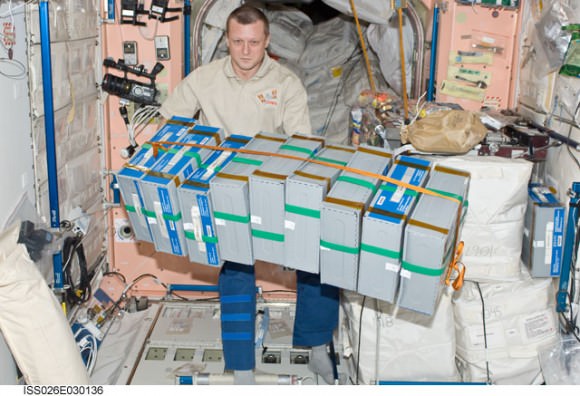
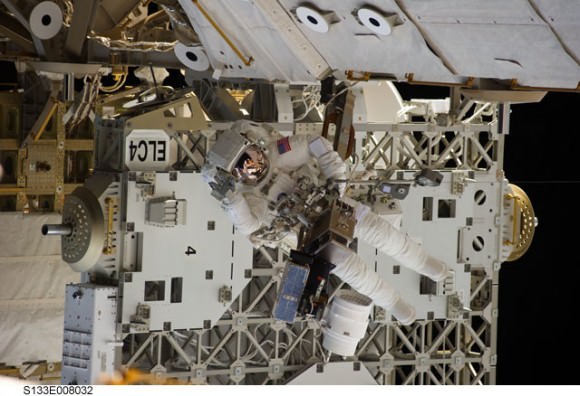
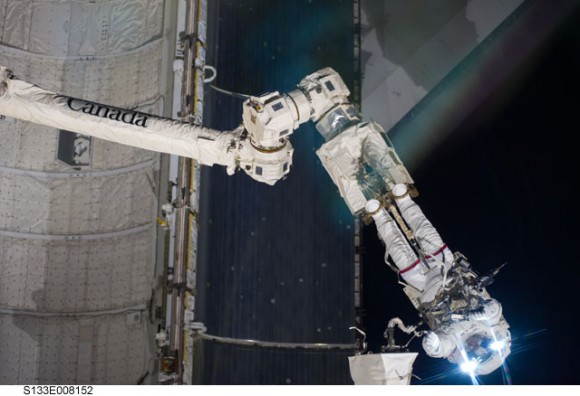
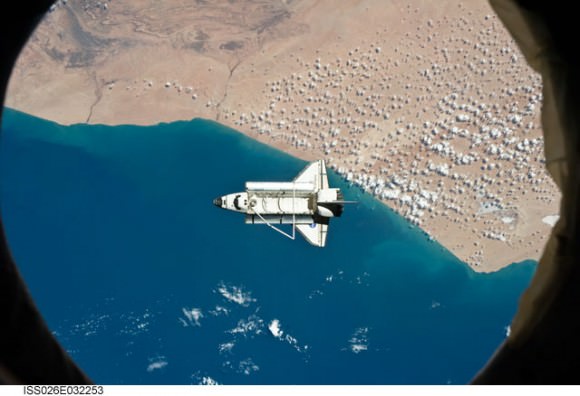
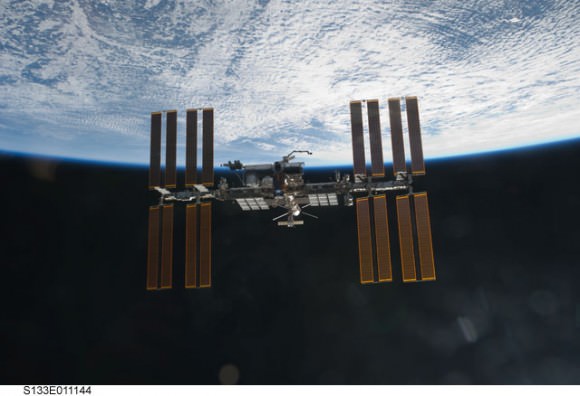

Larger versions of all these images can be found at NASA’s Human Spaceflight website, under the STS-133 gallery.
Click here to see our gallery of launch images for Discovery’s final flight.
Here’s a video recap of the STS-133 mission:
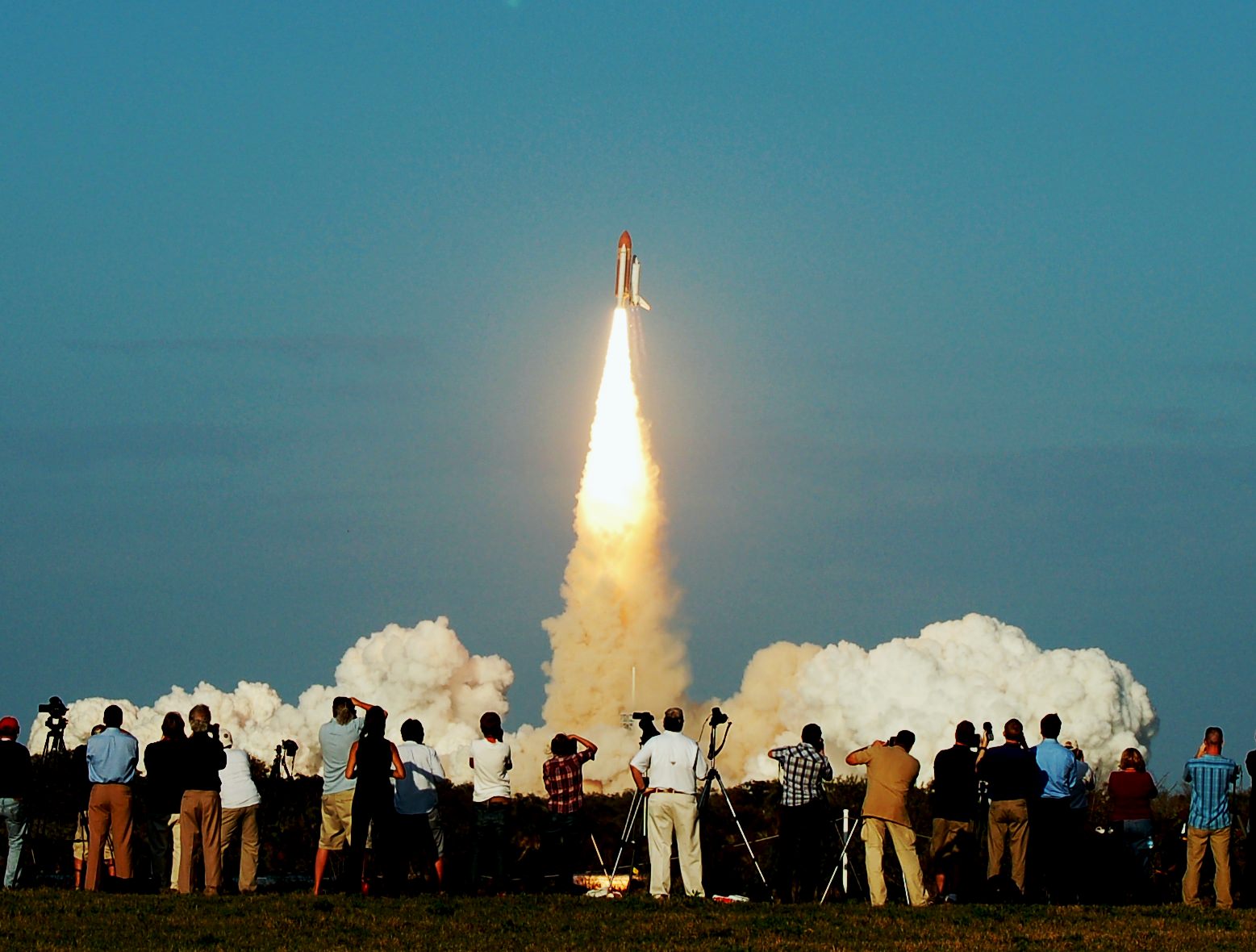
[/caption]
When it comes to space flight, the media, politicians and the public tend to focus on who was “first.” Many point to the fact that the Soviet Union was first to send both a satellite and man into orbit as the impetus behind the U.S. into the new frontier. However, the “lasts” are often lost to history, forgotten in the dusty pages of some biographer’s notes. As the shuttle era closes, there are several lasts that, so far, have gone unmentioned. More importantly, the program, as a whole, has been an incredibly powerful engine for change – both within the U.S. and abroad.
Alvin Drew is the last African-American currently scheduled to fly in the shuttle program. Additionally, there is one other last that may or may not be highlighted (if NASA gets the necessary funding for the mission) – the last woman to fly in the shuttle program – Sandra “Sandy” Magnus on STS-135. Although NASA has declared STS-135 an official mission, the funding needed to fly it, has yet to be approved.
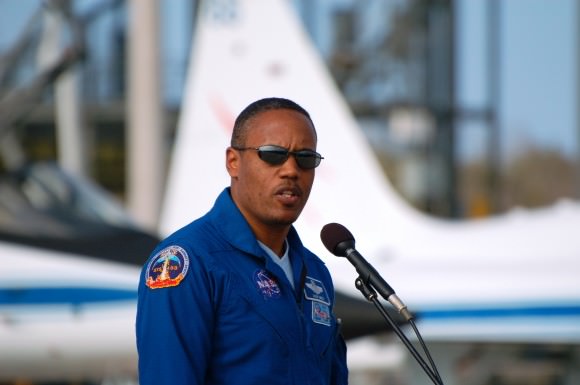
These two “lasts” may or may not be noted by the media, many of whom give the appearance of looking down on the program. The shuttle, as Bob Crippen once said is often “bad-mouthed” for not living up the expectations laid out at the beginning of the program. Perhaps, in time, the shuttle program will be remembered as what it was – an engine that worked to remove many social barriers. The shuttle era could, one day, be regarded as the program that opened space flight to people of all races and nations.
The number of nations that have flown astronauts onboard NASA’s fleet of shuttles is far more expansive than most think. Canada, Belgium, France, Germany, Italy, the Netherlands, Spain, Switzerland, Israel, Japan, Mexico, Russia, Saudi Arabia and the Ukraine have all flown astronauts aboard the space shuttle.
During the Mercury, Gemini and Apollo Programs the crews were universally white and male. With the shuttle’s capacity for larger crews – that dynamic changed. The U.S. flew its first woman, Sally Ride, in 1984 (the Soviet Union flew its first woman, Valentina Tereshkova in 1963) the first African-American, Guy Bluford also flew that year. After that the backgrounds of the astronauts who flew on the shuttle continued to diversify.
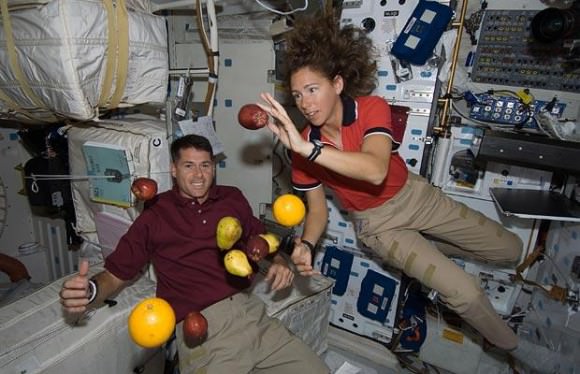
The first female pilot, Eileen Collins, flew on board STS-63 – she would go on to become the first female commander – and to return NASA to flight after the Columbia disaster on STS-114 in 2005. Charles Bolden, an African-American, commanded the first joint Russian/American shuttle mission (mission STS-61 on Discovery) and would go on to become the first African-American NASA administrator when he was selected in 2009. These are just two of numerous examples of how the shuttle has empowered different genders and races.
So while Drew’s and Magnus’ place in history may not be well remembered, those that paved the way for them as well as the shuttle’s capabilities made it all possible. Time will tell if the shuttle will be remembered for its shortcomings or if it will be remembered for allowing astronauts of all stripes to fly, for the Hubble Space Telescope to be deployed and serviced, for the International Space Station to be built and for all the other positive things that the shuttle made possible since it first flew in April of 1981.
“The shuttle has flown on such a routine basis for the past 30 years that many Americans may not realize the contributions it has made for all humankind,” said Candrea Thomas a NASA public affairs officer. “When the shuttles stop flying, I believe Americans will remember all the wonderful technologies and advancements that these amazing spacecraft, and the diverse group of people who worked on them, made possible.”